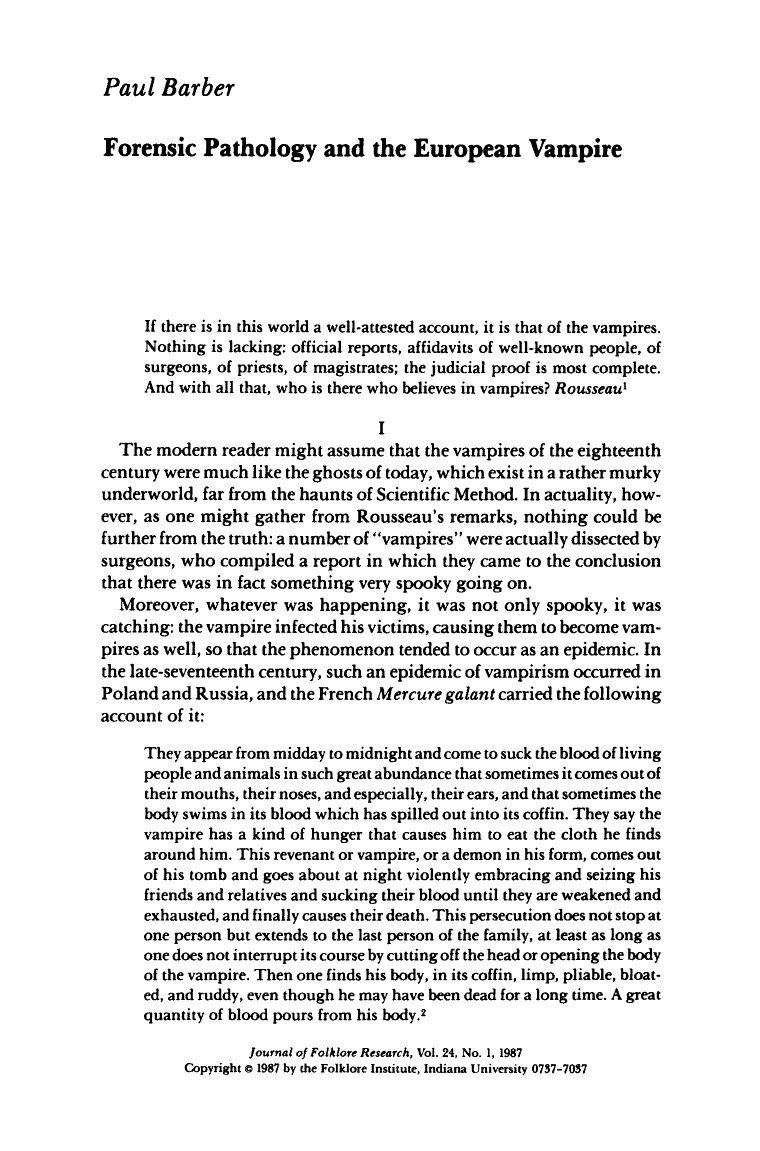The Origination of the Vampire
For years, people have been mystified with death and the phenomena that surround it. In the article “Forensic Pathology and the European Vampire” by Paul Barber, “the puzzling phenomena associated with death and decomposition” and how people have created folk hypotheses in order to attempt to explain these occurrences is addressed. Barber writes about accounts from the 17th and 18th centuries regarding vampires and death. He makes an interesting point in describing how even today, most individuals do not in fact know much of what exactly occurs and can occur to bodies after death, especially when concerning such phenomena regarding death that it should be expected only a coroner would likely know. Ultimately, the connection between the phenomena surrounding death and vampiric involvement is disproved by Barber, however, we learn that much of what we today view as hysteria from the past could be argued to have been understandable conclusions drawn from a lack of understanding. It should be noted that the phenomena surrounding death are not the only potential reasons for the legend of the vampire to come into being.

Vampiric Rituals and Customs
While rituals and customs fall under customary folklore which is not part of verbal and material folklore, they must be briefly addressed. Vampiric rituals and customs included staking a potential vampire through the heart to ensure that they were dead, wearing rosaries for protection, not inviting potential vampires into your home, and burying loved ones with specific items to ensure that they would not rise as a vampire. In the case of rituals concerning vampires, many early rituals were learned through verbal folklore. Rituals progressively shifted toward becoming known through literary works and eventually films and movies, showing how they have shifted into becoming part of material folklore. Ultimately, rituals shifted from being mainly dictated to becoming part of a combination of verbal and material folklore that we find today in the form of films and stories.

Vampiric Seduction and Corruption
An In Depth Explanation
The art of seduction in relation to vampires cannot solely be attributed to the present. Looking at Bram Stoker’s Dracula, we see the corrupting influence of the vampire as well as the Englishmen who fought to defeat the vampire’s corruption. The article “Vampiric Seduction and Vicissitudes of Masculine Identity in Bram Stoker’s ‘Dracula’” by Dejan Kuzmanovic addresses the features of corruption present within the book Dracula. Within the novel, female sexual expression, the promise of Christian salvation, madness, and a fear of outsiders is represented. Concerning female sexual expression, at the time of the novel’s publication (1897), according to sparknotes.com, “A Victorian woman effectively had only two options: she was either a virgin—a model of purity and innocence—or else she was a wife and mother. If she was neither of these, she was considered a whore, and thus of no consequence to society.” When Dracula converts one of the women present in the novel, Lucy Westenra, into a vampire, the certain Englishmen of the novel decide that the only option is to kill her. This is done in order to, according to sparknotes.com, “return her to a purer, more socially respectable state.” Not only is female sexual expression present in the novel, but also elements of homosexuality that add to the theme of corruption that Kuzmanovic identifies. As you may know, homosexuality was viewed by the majority of Victorian society as being sinful and impure. According to Kuzmanovic, a character of the novel, Jonathan Harker, is targeted by Dracula’s seduction.
A Change of Narrative
Bram Stoker’s Dracula changed the narrative of the vampire into being, according to western culture, a symbol of foreign corruption, seduction, madness, and wrongness. Of course, when looking at early literary works regarding vampires, one must also look at The Vampyre by John William Polidori (1819). According to wikipedia.org, “The Vampyre is often viewed as the progenitor of the romantic vampire genre of fantasy fiction. The work is described by Christopher Frayling as ‘the first story successfully to fuse the disparate elements of vampirism into a coherent literary genre."’ The story molded the vampire into how the vampire is now commonly viewed. It incorporates the verbal vampire folklore of Eastern Europe while also showing how the vampire of today differs from that of the past. Reading accounts of the past along with the book The Vampyre, we find that the modern vampire has evolved and learned how to incorporate itself into society. We see this aspect in future works such as Bram Stoker’s Dracula and the Twilight series. Both Bram Stoker’s Dracula and John William Polidori’s The Vampyre progressed the vampire from folk stories and local accounts to an international account, from old accounts of vampires into how they are viewed today.